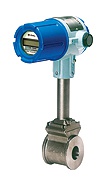Guided wave radar
A high-speed Guided Wave Radar (GWR) transmitter
Micropower impulse radar (MIR) combines time domain reflectometry (TDR), equivalent time sampling (ETS), and modern low power circuitry. This synthesis of technologies creates a high-speed Guided Wave Radar (GWR) transmitter. The electromagnetic pulses are propagated via a waveguide that focuses the energy and yields a system many times more efficient than Non-Contact Radar.
Time domain reflectometry (TDR)
TDR uses pulses of electromagnetic (EM) energy to measure distances or levels. When a pulse reaches a dielectric discontinuity (such as one created by a media surface), a portion of the pulse is reflected. The greater the dielectric difference between air and the process medium being measured, the greater the amplitude of the reflection.
Although TDR is relatively new to the industrial level measurement industry, it has been used in the telephone, computer, and power transmission industries for years. In these industries, it is used to successfully locate wire or cable breaks and shorts. An EM pulse is sent through the wire, traveling unimpeded until it finds a line break or short. A reflection is then returned from the break, and a timing circuit pinpoints the location.
In the Eclipse GWR transmitter, a waveguide with a known characteristic impedance in air is used as a probe. When part of the probe is immersed in a material other than air, there is lower impedance due to the increase in the dielectric. When an EM pulse is sent down the probe and meets the dielectric discontinuity, a reflection is generated.

Equivalent time sampling (ETS)
ETS, or Equivalent Time Sampling, is used to measure the high speed, low power EM energy. ETS is a critical key in the application of TDR to vessel level measurement technology. The high speed EM energy (1000 ft/us) is difficult to measure over short distances and at the resolution required in the process industry. ETS captures the EM signals in real time (nanoseconds) and reconstructs them in equivalent time (milliseconds), which is much easier to measure with today's technology.
ETS is accomplished by scanning the waveguide to collect thousands of samples. Approximately 5 scans are taken per second; each scan gathers more than 50,000 samples.
Share:











